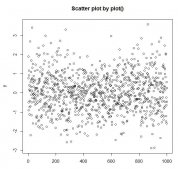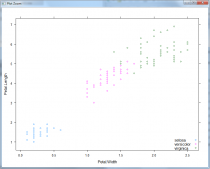数据帧是表或二维阵列状结构,其中每一列包含一个变量的值,并且每一行包含来自每一列的一组值。
以下是数据帧的特性。
- 列名称应为非空。
- 行名称应该是唯一的。
- 存储在数据帧中的数据可以是数字,因子或字符类型。
- 每个列应包含相同数量的数据项。
创建数据帧
|
1
2
3
4
5
6
7
8
9
10
11
12
|
# Create the data frame.emp.data <- data.frame( emp_id = c (1:5), emp_name = c("Rick","Dan","Michelle","Ryan","Gary"), salary = c(623.3,515.2,611.0,729.0,843.25), start_date = as.Date(c("2012-01-01", "2013-09-23", "2014-11-15", "2014-05-11", "2015-03-27")), stringsAsFactors = FALSE)# Print the data frame. print(emp.data) |
当我们执行上面的代码,它产生以下结果 -
|
1
2
3
4
5
6
|
emp_id emp_name salary start_date1 1 Rick 623.30 2012-01-012 2 Dan 515.20 2013-09-233 3 Michelle 611.00 2014-11-154 4 Ryan 729.00 2014-05-115 5 Gary 843.25 2015-03-27 |
获取数据帧的结构
通过使用str()函数可以看到数据帧的结构。
|
1
2
3
4
5
6
7
8
9
10
11
12
|
# Create the data frame.emp.data <- data.frame( emp_id = c (1:5), emp_name = c("Rick","Dan","Michelle","Ryan","Gary"), salary = c(623.3,515.2,611.0,729.0,843.25), start_date = as.Date(c("2012-01-01", "2013-09-23", "2014-11-15", "2014-05-11", "2015-03-27")), stringsAsFactors = FALSE)# Get the structure of the data frame.str(emp.data) |
当我们执行上面的代码,它产生以下结果 -
|
1
2
3
4
5
|
'data.frame': 5 obs. of 4 variables: $ emp_id : int 1 2 3 4 5 $ emp_name : chr "Rick" "Dan" "Michelle" "Ryan" ... $ salary : num 623 515 611 729 843 $ start_date: Date, format: "2012-01-01" "2013-09-23" "2014-11-15" "2014-05-11" ... |
数据框中的数据摘要
可以通过应用summary()函数获取数据的统计摘要和性质。
|
1
2
3
4
5
6
7
8
9
10
11
12
|
# Create the data frame.emp.data <- data.frame( emp_id = c (1:5), emp_name = c("Rick","Dan","Michelle","Ryan","Gary"), salary = c(623.3,515.2,611.0,729.0,843.25), start_date = as.Date(c("2012-01-01", "2013-09-23", "2014-11-15", "2014-05-11", "2015-03-27")), stringsAsFactors = FALSE)# Print the summary.print(summary(emp.data)) |
当我们执行上面的代码,它产生以下结果 -
|
1
2
3
4
5
6
7
|
emp_id emp_name salary start_date Min. :1 Length:5 Min. :515.2 Min. :2012-01-01 1st Qu.:2 Class :character 1st Qu.:611.0 1st Qu.:2013-09-23 Median :3 Mode :character Median :623.3 Median :2014-05-11 Mean :3 Mean :664.4 Mean :2014-01-14 3rd Qu.:4 3rd Qu.:729.0 3rd Qu.:2014-11-15 Max. :5 Max. :843.2 Max. :2015-03-27 |
从数据帧提取数据
使用列名称从数据框中提取特定列。
|
1
2
3
4
5
6
7
8
9
10
11
12
13
|
# Create the data frame.emp.data <- data.frame( emp_id = c (1:5), emp_name = c("Rick","Dan","Michelle","Ryan","Gary"), salary = c(623.3,515.2,611.0,729.0,843.25), start_date = as.Date(c("2012-01-01","2013-09-23","2014-11-15","2014-05-11", "2015-03-27")), stringsAsFactors = FALSE)# Extract Specific columns.result <- data.frame(emp.data$emp_name,emp.data$salary)print(result) |
当我们执行上面的代码,它产生以下结果 -
|
1
2
3
4
5
6
|
emp.data.emp_name emp.data.salary1 Rick 623.302 Dan 515.203 Michelle 611.004 Ryan 729.005 Gary 843.25 |
先提取前两行,然后提取所有列
|
1
2
3
4
5
6
7
8
9
10
11
12
13
|
# Create the data frame.emp.data <- data.frame( emp_id = c (1:5), emp_name = c("Rick","Dan","Michelle","Ryan","Gary"), salary = c(623.3,515.2,611.0,729.0,843.25), start_date = as.Date(c("2012-01-01", "2013-09-23", "2014-11-15", "2014-05-11", "2015-03-27")), stringsAsFactors = FALSE)# Extract first two rows.result <- emp.data[1:2,]print(result) |
当我们执行上面的代码,它产生以下结果 -
|
1
2
3
|
emp_id emp_name salary start_date1 1 Rick 623.3 2012-01-012 2 Dan 515.2 2013-09-23 |
用第2和第4列提取第3和第5行
|
1
2
3
4
5
6
7
8
9
10
11
12
13
14
|
# Create the data frame.emp.data <- data.frame( emp_id = c (1:5), emp_name = c("Rick","Dan","Michelle","Ryan","Gary"), salary = c(623.3,515.2,611.0,729.0,843.25), start_date = as.Date(c("2012-01-01", "2013-09-23", "2014-11-15", "2014-05-11", "2015-03-27")), stringsAsFactors = FALSE)# Extract 3rd and 5th row with 2nd and 4th column.result <- emp.data[c(3,5),c(2,4)]print(result) |
当我们执行上面的代码,它产生以下结果 -
|
1
2
3
|
emp_name start_date3 Michelle 2014-11-155 Gary 2015-03-27 |
扩展数据帧
可以通过添加列和行来扩展数据帧。
添加列
只需使用新的列名称添加列向量。
|
1
2
3
4
5
6
7
8
9
10
11
12
13
14
15
|
# Create the data frame.emp.data <- data.frame( emp_id = c (1:5), emp_name = c("Rick","Dan","Michelle","Ryan","Gary"), salary = c(623.3,515.2,611.0,729.0,843.25), start_date = as.Date(c("2012-01-01", "2013-09-23", "2014-11-15", "2014-05-11", "2015-03-27")), stringsAsFactors = FALSE)# Add the "dept" coulmn.emp.data$dept <- c("IT","Operations","IT","HR","Finance")v <- emp.dataprint(v) |
当我们执行上面的代码,它产生以下结果 -
|
1
2
3
4
5
6
|
emp_id emp_name salary start_date dept1 1 Rick 623.30 2012-01-01 IT2 2 Dan 515.20 2013-09-23 Operations3 3 Michelle 611.00 2014-11-15 IT4 4 Ryan 729.00 2014-05-11 HR5 5 Gary 843.25 2015-03-27 Finance |
添加行
要将更多行永久添加到现有数据帧,我们需要引入与现有数据帧相同结构的新行,并使用rbind()函数。
在下面的示例中,我们创建一个包含新行的数据帧,并将其与现有数据帧合并以创建最终数据帧。
|
1
2
3
4
5
6
7
8
9
10
11
12
13
14
15
16
17
18
19
20
21
22
23
24
25
|
# Create the first data frame.emp.data <- data.frame( emp_id = c (1:5), emp_name = c("Rick","Dan","Michelle","Ryan","Gary"), salary = c(623.3,515.2,611.0,729.0,843.25), start_date = as.Date(c("2012-01-01", "2013-09-23", "2014-11-15", "2014-05-11", "2015-03-27")), dept = c("IT","Operations","IT","HR","Finance"), stringsAsFactors = FALSE)# Create the second data frameemp.newdata <- data.frame( emp_id = c (6:8), emp_name = c("Rasmi","Pranab","Tusar"), salary = c(578.0,722.5,632.8), start_date = as.Date(c("2013-05-21","2013-07-30","2014-06-17")), dept = c("IT","Operations","Fianance"), stringsAsFactors = FALSE)# Bind the two data frames.emp.finaldata <- rbind(emp.data,emp.newdata)print(emp.finaldata) |
当我们执行上面的代码,它产生以下结果 -
|
1
2
3
4
5
6
7
8
9
|
emp_id emp_name salary start_date dept1 1 Rick 623.30 2012-01-01 IT2 2 Dan 515.20 2013-09-23 Operations3 3 Michelle 611.00 2014-11-15 IT4 4 Ryan 729.00 2014-05-11 HR5 5 Gary 843.25 2015-03-27 Finance6 6 Rasmi 578.00 2013-05-21 IT7 7 Pranab 722.50 2013-07-30 Operations8 8 Tusar 632.80 2014-06-17 Fianance |
到此这篇关于R语言关于数据帧的知识点详解的文章就介绍到这了,更多相关R语言数据帧内容请搜索服务器之家以前的文章或继续浏览下面的相关文章希望大家以后多多支持服务器之家!
原文链接:https://www.w3cschool.cn/r/r_data_frames.html

















